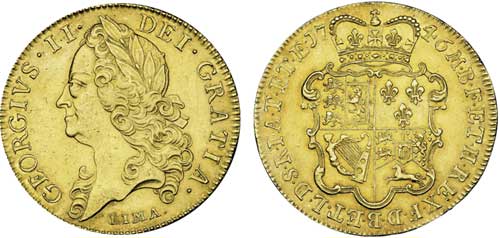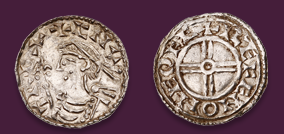
Auction: 5028 - The Samuel King Collection of Highly Important British Gold Coins
Lot: 168
xGeorge II, Five Guineas, 1746, lima. below old laureate head left, georgivs.ii. dei.gratia., toothed border both sides, rev. inverted die axis, crowned quartered shield of arms, revised garnishing, crown band more ornate, ten hearts to Hanoverian Arms, nine strings to Irish harp, Scottish Arms with inner frame of lis more crudely engraved, date at top, .m.b.f.et.h.rex.f.d.b.et.l.d.s.r.i.a.t.et.e., edge inverted inscription in raised letters decvs.et.tvtamen anno.regni.decimo.nono. (Schneider 564; MCE.285; S.3665), some light surface marks mainly on obverse, toned good very fine Estimate £ 5,000-6,000 Stacks, New York, 29 November 1990, lot 928The 1740s was a fruitful decade for English privateering at the expense of the French and Spanish trade. It is generally believed that the LIMA coinage of 1745-46 was struck from bullion captured from the Mexican silver fleet by Admiral Anson in the Pacific during his circumnavigation of the globe. However, studies have shown that the main source of bullion came from two French ships transporting Peruvian precious metals via the treasure ports of the West Indies and captured by the privateer, Captain James Talbot. The prize was unloaded at Bristol and brought to London in forty-five wagons bedecked in garlands. One of the victorious lieutenants from Talbot´s ship noted ´its arrival in the capital and removal to the mint caused a great sensation and kindled a new passion for privateering.´1 The addition of the word LIMA under The King´s head acknowledged the Peruvian source of the bullion which was issued as gold Five Guinea, Guinea, Half Guinea pieces and silver Crowns, Halfcrowns, Shillings and Sixpences.1 J. D. A. Thompson, ´Notes on the Lima Treasure´, Numismatic Circular, June 1963
Sold for
£5,000




